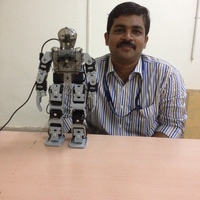Papers by Miroslaw Mikolajewski

2020 Baltic URSI Symposium (URSI)
In high-efficiency Class E amplifiers matching circuits are commonly used to transform usually co... more In high-efficiency Class E amplifiers matching circuits are commonly used to transform usually constant load resistance to nominal or off-nominal resistance of the amplifier to ensure its ZVS operation. In some applications such as: wireless power transfer systems, plasma generators, dc-dc power converters as well as in some transmitters Class E amplifiers operate with load resistance or impedance varied in a wide range. This requires the matching circuit to transform the whole range of load resistance into the range of nominal and off-nominal resistance of the amplifier. The paper presents theoretical results for Class E ZVS amplifier with basic parallel π 1a and π2a matching circuits loaded with variable resistance. Conditions for ZVS operation of the amplifier with transistor duty cycle D=0.5 and the matching circuits loaded with any load resistance are discussed. Analytical expressions setting the boundaries for ZVS operation of the Class E amplifier with the analyzed matching circuits are given as well. Examples of normalized characteristics of output voltage and output power vs. load resistance for the amplifier are also presented. A design example for the Class E amplifier with π1a matching circuit able to operate with any load resistance is described and verified by simulation with LTSpice.

2020 Baltic URSI Symposium (URSI), 2020
In some applications such as radio transmitters with loop antennas, h.f. drivers for RFID transmi... more In some applications such as radio transmitters with loop antennas, h.f. drivers for RFID transmitting coils, wireless h.f. power supplies for biomedical implants and endoscope capsules etc. resonant power amplifiers operate with high-reactance and low-resistance load. The paper analyses an off-nominal Class E ZVS amplifier to identify conditions for its high-efficiency operation with low-resistance load. Power loss of the transistor switch in Class E amplifiers with normalized transistor turn-on time D= 0.5 operating in nominal and off-nominal conditions are compared. Analytical closed-form estimations for power losses in the transistor switch in the off-nominal amplifier are given. Theoretical results experimentally validated have demonstrated that by designing the off-nominal Class E amplifier for a high enough dc supply voltage the power losses in the transistor switch can be significantly reduced. This makes the circuit useful in those applications that require the amplifier to...
Proceedings of the 2005 European Conference on Circuit Theory and Design, 2005., 2005
Output power of transistorised high-power high-frequency converters can be controlled utilising t... more Output power of transistorised high-power high-frequency converters can be controlled utilising their specific structure consisting of a set of amplifiers the power of which is combined. The output power of such a converter can be controlled by varying the number of combined amplifiers versus the control signal. In the controlled power-combining network there can be used class-DE power amplifiers operating in zero-voltage-switching conditions, which assures high efficiency for any nonzero output power. The paper presents a theoretical analysis for a power-combining converter with class-DE amplifiers and experimental results obtained for a five-stage 500kHz/700W laboratory model. Advantages and limitations of the power-control method are also discussed.

A high-frequency power amplifier used in a drain amplitude modulator must have linear dependence ... more A high-frequency power amplifier used in a drain amplitude modulator must have linear dependence of output HF voltage V o V o V o versus its supply voltage V DD V DD V DD . This condition essential for obtaining low-level envelope distortions is met by a theoretical class-E amplifier with a linear shunt capacitance of the switch. In this paper the influence of non-linear output capacitance of the transistor in the class-E amplifier on its ) characteristic is analyzed using PSPICE simulations of the amplifiers operating at frequencies 0.5 MHz, 5 MHz and 7 MHz. These simulations have proven that distortions of the ) characteristic caused by non-linear output capacitance of the transistor are only slight for all analyzed amplifiers, even for the 7 MHz amplifier without the external (linear) shunt capacitance. In contrast, the decrease of power efficiency of the class-E amplifier resulting from this effect can be significant even by 40%.
A HF power amplifier used in drain amplitude modulator must have a linear static modulation chara... more A HF power amplifier used in drain amplitude modulator must have a linear static modulation characteristic i.e. linear dependence of amplifier HF output voltage vs. its supply voltage. This condition essential for obtaining low-level envelope distortions is theoretically met by a class-E amplifier. In this paper the influence of non-linear output capacitance of the transistor in the class-E amplifier on its static modulation characteristic is analyzed. Simulations with PSPICE of class-E amplifiers operating at frequencies 0.5 MHz, 5 MHz and 7 MHz have proven that distortions of the amplifier static modulation characteristic caused by non-linear output capacitance of the amplifier transistor are only slight. However, the decrease of power efficiency of the class E amplifier resulting from non-linearity of transistor output capacitance can be significant even by 40%.

EUROCON 2007 - The International Conference on "Computer as a Tool", 2007
A Class DE or Class D Zero-Voltage Switching amplifier is a high-efficiency, radio-frequency powe... more A Class DE or Class D Zero-Voltage Switching amplifier is a high-efficiency, radio-frequency power amplifier which also finds application in various power conversion industrial circuits such as dc/dc converters as well as dielectric and induction heaters. The output voltage (current or power) in these circuits can be controlled by varying the Class-DE-amplifier operating frequency and maintaining high efficiency over a wide range of output power. In the paper the computer-aided first-harmonic method is used to find relations defining parameters of the Class-DE amplifier vs. its operating frequency for the constant load resistance. It has been shown that by decreasing the operating frequency of the Class-DE-amplifier in the optimum mode its output voltage is increased. Unfortunately, then the efficiency is reduced because the transistors leave the ZVS region and their power losses rise. In contrast, by increasing the amplifier operating frequency its output voltage is decreased maintaining the ZVS operation and high efficiency (sub-optimum mode). The operating frequency can be increased up to the value corresponding to the second optimum operation mode of the Class-DE amplifier. The theoretical results have been verified by computer simulation with SPICE program as well as by experimental tests carried out for 1MHz 265W Class-DE amplifier (measured efficiency exceeded 96%).
2006 International Conference on Microwaves, Radar & Wireless Communications, 2006
ABSTRACT One of basic problems in a Class E amplifier operating at a high frequency is an appropr... more ABSTRACT One of basic problems in a Class E amplifier operating at a high frequency is an appropriate drive circuit ensuring switch-mode operation of the amplifier transistor. The paper analyzes the influence of various methods of sine-wave driving on parameters of the Class E amplifier. Advantages and disadvantages of these methods are presented along with simulation data and experimental results for a 12W/500kHz laboratory model.

A high-frequency power amplifier used in a drain amplitude modulator must have linear dependence ... more A high-frequency power amplifier used in a drain amplitude modulator must have linear dependence of output HF voltage V o V o V o versus its supply voltage V DD V DD V DD . This condition essential for obtaining low-level envelope distortions is met by a theoretical class-E amplifier with a linear shunt capaci-tance of the switch. In this paper the influence of non-linear output capacitance of the transistor in the class-E amplifier on its V o (V DD) V o (V DD) V o (V DD) characteristic is analyzed using PSPICE sim-ulations of the amplifiers operating at frequencies 0.5 MHz, 5 MHz and 7 MHz. These simulations have proven that distor-tions of the V o (V DD V o (V DD V o (V DD) characteristic caused by non-linear output capacitance of the transistor are only slight for all analyzed amplifiers, even for the 7 MHz amplifier without the external (linear) shunt capacitance. In contrast, the decrease of power efficiency of the class-E amplifier resulting from this effect can be significant...

Proceedings of IEEE International Symposium on Industrial Electronics, 1996
ABSTRACT A transformer regulated synchronous high-frequency rectifier is described, analysed and ... more ABSTRACT A transformer regulated synchronous high-frequency rectifier is described, analysed and experimentally tested. The rectifier can be applied to high power resonant DC/DC power converters with Class D or Class E DC/AC inverters operating at a constant frequency. In the rectifier, a HF power transformer is utilised to separate the regulating and rectifying elements of the circuit. This approach allows reducing conduction losses in the regulating transistors and achieving good efficiency. Design examples and experimental results for 240 W/V0 =12 V Class D and 50 W/V0=5 V Class E DC/DC power converters are also presented. The power converters operated at a constant frequency (approx. 1 MHz) in a wide range of loads (from no load to short circuit) and achieved good efficiency 89% and 82% at a full load, respectively. Possible modifications of the circuits are also discussed. DC/DC resonant power converters with the proposed rectifier are suitable for noise sensitive applications where a high constant frequency of operation and a high output current and/or voltage are required (e.g. telecommunications, aircraft and satellite equipment). The power converters can also be built as multiple output circuits with independent regulation of each output voltage

Archives of Electrical Engineering, 2014
ABSTRACT In a high-efficiency Class E ZVS resonant amplifier a matching and isolation transformer... more ABSTRACT In a high-efficiency Class E ZVS resonant amplifier a matching and isolation transformer can replace some or even all inductive components of the amplifier thus simplifying the circuit and reducing its cost. In the paper a theoretical analysis, a design example and its experimental verification for a transformer Class E amplifier are presented. In the experimental amplifier with a transformer as the only inductive component in the circuit high efficiency ηMAX = 0.95 was achieved for supply voltage VI = 36 V, maximum output power POMAX = 100 W and the switching frequency f = 300 kHz. Measured parameters and waveforms showed a good agreement with theoretical predictions. Moreover, the relative bandwidth of the switching frequency was only 19% to obtain output power control from 4.8 W to POMAX with efficiency not less than 0.9 in the regulation range.
A HF power amplifier used in drain amplitude modulator must have a linear static modulation chara... more A HF power amplifier used in drain amplitude modulator must have a linear static modulation characteristic i.e. linear dependence of amplifier HF output voltage vs. its supply voltage. This condition essential for obtaining low-level envelope distortions is theoretically met by a class-E amplifier. In this paper the influence of non-linear output capacitance of the transistor in the class-E amplifier on its static modulation characteristic is analyzed. Simulations with PSPICE of class-E amplifiers operating at frequencies 0.5 MHz, 5 MHz and 7 MHz have proven that distortions of the amplifier static modulation characteristic caused by non-linear output capacitance of the amplifier transistor are only slight. However, the decrease of power efficiency of the class E amplifier resulting from non-linearity of transistor output capacitance can be significant even by 40%.

A Class DE or Class D Zero-Voltage Switching amplifier is a high-efficiency, radio-frequency powe... more A Class DE or Class D Zero-Voltage Switching amplifier is a high-efficiency, radio-frequency power amplifier which also finds application in various power conversion industrial circuits such as dc/dc converters as well as dielectric and induction heaters. The output voltage (current or power) in these circuits can be controlled by varying the Class-DE-amplifier operating frequency and maintaining high efficiency over a wide range of output power. In the paper the computer-aided first-harmonic method is used to find relations defining parameters of the Class-DE amplifier vs. its operating frequency for the constant load resistance. It has been shown that by decreasing the operating frequency of the Class-DE-amplifier in the optimum mode its output voltage is increased. Unfortunately, then the efficiency is reduced because the transistors leave the ZVS region and their power losses rise. In contrast, by increasing the amplifier operating frequency its output voltage is decreased maint...
2006 International Conference on Microwaves, Radar & Wireless Communications, 2006
ABSTRACT One of basic problems in a Class E amplifier operating at a high frequency is an appropr... more ABSTRACT One of basic problems in a Class E amplifier operating at a high frequency is an appropriate drive circuit ensuring switch-mode operation of the amplifier transistor. The paper analyzes the influence of various methods of sine-wave driving on parameters of the Class E amplifier. Advantages and disadvantages of these methods are presented along with simulation data and experimental results for a 12W/500kHz laboratory model.
Output power of transistorised high-power high-frequency converters can be controlled utilising t... more Output power of transistorised high-power high-frequency converters can be controlled utilising their specific structure consisting of a set of amplifiers the power of which is combined. The output power of such a converter can be controlled by varying the number of combined amplifiers versus the control signal. In the controlled power-combining network there can be used class-DE power amplifiers operating in zero-voltage-switching conditions, which assures high efficiency for any nonzero output power. The paper presents a theoretical analysis for a power-combining converter with class-DE amplifiers and experimental results obtained for a five-stage 500kHz/700W laboratory model. Advantages and limitations of the power-control method are also discussed.
IEEE Transactions on Power Electronics, 1993
Absfruct-Class E zero-voltage-ripple (ZVR) rectifiers are in-troduced. The proposed circuits offe... more Absfruct-Class E zero-voltage-ripple (ZVR) rectifiers are in-troduced. The proposed circuits offer a new means of a significant improvement in suppressing the output-voltage ripple compared with their predecessors. Therefore, the size of the output filter can be considerably ...

A high-frequency power amplifier used in a drain amplitude modulator must have linear dependence ... more A high-frequency power amplifier used in a drain amplitude modulator must have linear dependence of output HF voltage V o V o V o versus its supply voltage V DD V DD V DD . This condition essential for obtaining low-level envelope distortions is met by a theoretical class-E amplifier with a linear shunt capaci-tance of the switch. In this paper the influence of non-linear output capacitance of the transistor in the class-E amplifier on its V o (V DD) V o (V DD) V o (V DD) characteristic is analyzed using PSPICE sim-ulations of the amplifiers operating at frequencies 0.5 MHz, 5 MHz and 7 MHz. These simulations have proven that distor-tions of the V o (V DD V o (V DD V o (V DD) characteristic caused by non-linear output capacitance of the transistor are only slight for all analyzed amplifiers, even for the 7 MHz amplifier without the external (linear) shunt capacitance. In contrast, the decrease of power efficiency of the class-E amplifier resulting from this effect can be significant...









Uploads
Papers by Miroslaw Mikolajewski